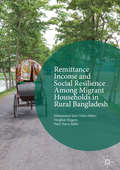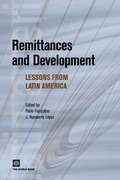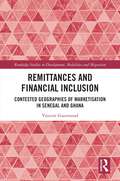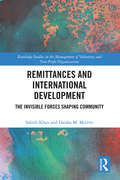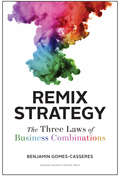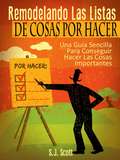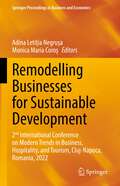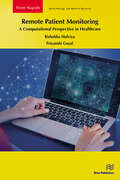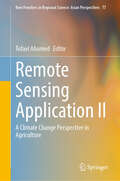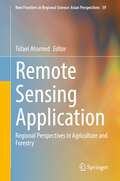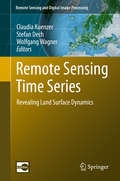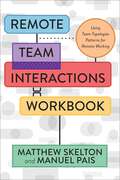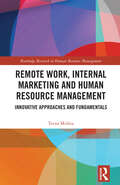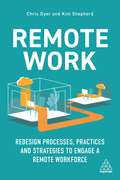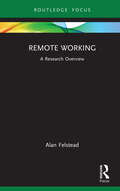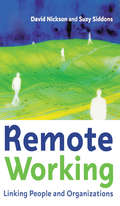- Table View
- List View
Remittance Income and Social Resilience among Migrant Households in Rural Bangladesh
by Vaughan Higgins Mohammad Jalal Uddin Sikder Peter Harry BallisThis book examines how migrant remittances contribute to household social resilience in rural Bangladesh. Using a mixed methods approach, the authors show that remittances play a crucial role in enhancing the life chances and economic livelihoods of rural households, and that remittance income enables households to overcome immediate pressures, adapt to economic and environmental change, build economic and cultural capital, and provide greater certainty in planning for the future. However, the book also reveals that the social and economic benefits of remittances are not experienced equally by all households. Rural village households endure a precarious existence and the potentially positive outcomes of remittances can easily be undermined by a range of external and household-specific factors leading to few, if any, benefits in terms of household social resilience.
Remittance Markets in Africa
by Dilip Ratha Sanket MohapatraRemittances sent by African migrants have become an important source of external finance for countries in the Sub-Saharan African region. In many African countries, these flows are larger than foreign direct investment and portfolio debt and equity flows. In some cases, they are similar in size to official aid from multilateral and bilateral donors. Remittance markets in Africa, however, remain less developed than other regions. The share of informal or unrecorded remittances is among the highest for Sub-Saharan African countries. Remittance costs tend to be significantly higher in Africa both for sending remittances from outside the region and for within-Africa (South-South) remittance corridors. At the same time, the remittance landscape in Africa is rapidly changing with the introduction of new remittance technologies, in particular mobile money transfers and branchless banking. This book presents findings of surveys of remittance service providers conducted in eight Sub-Saharan African countries and in three key destination countries. It looks at issues relating to costs, competition, innovation and regulation, and discusses policy options for leveraging remittances for development in Africa.
Remittances and Development
by Pablo Fajnzylber J. Humberto LopezThe editors (senior economists at the Office of the Chief Economist for the Latin America and the Caribbean Region, World Bank) present ten papers that analyze cross-country panel data and household surveys for 11 Latin American countries in order to assess the economic effects of worker remittance flows for development. Separately, the collections papers discuss patterns and determinants of migration and remittances, remittances and poverty levels, remittances and household behavior, remittances and recipient countries' financial development, the impact of public transfers on remittances, remittances and real exchange rates, remittance flows and system security, and the role of complementary policies for remittances and growth. Annotation ©2008 Book News, Inc. , Portland, OR (booknews. com)
Remittances and Financial Inclusion: Contested Geographies of Marketisation in Senegal and Ghana (Routledge Studies in Development, Mobilities and Migration)
by Vincent GuermondThis book comprehensively explores the messy and contested relationship between everyday practices of remittance sending and receiving, processes of market making, and operations of micro- and global finance. Remittances and Financial Inclusion critically investigates a global migration-development agenda that aims to harness remittances for development by incorporating remittance flows and households into global financial circuits. The book develops a multidisciplinary perspective and combines insights from economic, development, and financial geography as well as international political economy and economic anthropology. It sets out a geographies of remittance marketisation approach to investigate the intricate and grounded ways in which remittance markets are constructed, the extent to which remittance flows and households can be (re)configured and incorporated into global finance, and why such processes are always fragile, contested, and in need of constant renegotiation. Drawing on extensive fieldwork research, the book provides an in-depth critical interrogation of the policies and initiatives that underpin remittance marketisation in Senegal, Ghana, and beyond. This volume will be especially useful to those researching and working in the areas of international development, contemporary geographies of finance and market making, and migration and remittances. It should also prove of interest to policymakers, practitioners, and activists concerned with the relation between migration, remittances, and finance in the Global South.
Remittances and International Development: The Invisible Forces Shaping Community (Routledge Studies in the Management of Voluntary and Non-Profit Organizations)
by Sabith Khan Daisha M. MerrittThis is a first of its kind book which examines the remittances in the two largest corridors in the World: India-Saudi Arabia and Mexico-U.S.A. This book aims to treat remittances as an act of social norm involving individuals, nation-states, and diaspora communities. It treats remittances both as an act of individual obligation as well as a social fact that needs to be understood from the perspective of the actors, i.e., the givers and recipients. Using theories of motives of giving, policy analysis, international development, and international relations, the authors offer a compelling narrative of how and why remittances occur and the impacts on both the giver and recipient. The authors - both scholars of philanthropy and remittances - bring their shared perspective and understanding of this crucial phenomenon and delve deep into examining its impacts on community development and the relations between the nation-states. This book offers a sophisticated understanding of how vital remittances are to the world we live in. The book sheds light on this important social reality and will be of value to researchers, academics, and students interested in remittances, as well as to practitioners working in the international development sector, NGO actors, and policy makers.
Remittances as Social Practices and Agents of Change: The Future of Transnational Society
by Silke Meyer Claudius StröhleThis open access book explores the transformative effects of remittances. Remittances are conceptualized as flows of money, objects, ideas, traditions, and symbolic capital, mapping out a cross-border space in which people live, work, and communicate with multiple belongings. By doing so, they effect social change both in places of origin and destination. However, their power to improve individual living conditions and community infrastructure mainly results from global inequality. Hence, we challenge the remittance mantra and go beyond the migration-development-nexus by revealing dependencies and frictions in remittance relations. Remittances are thus scrutinized in their effects on both social cohesion and social rupture. By highlighting the transformative effects of remittance in the context of conflict, climate change, and the postcolonial, we shed light on the future of transnational society.Presenting empirical case studies from Ghana, Burkina Faso, Sri Lanka, New Zealand, Turkey, Lebanon, USA, Japan, and various European countries, as well as historical North America and the Habsburg Empire, we explore remittance relations from a range of disciplines including anthropology, sociology, history, design, architecture, governance, and peace studies.
Remittances: An Automatic Output Stabilizer?
by Dalia Hakura Ralph Chami Peter MontielA report from the International Monetary Fund.
Remix Strategy
by Benjamin Gomes-CasseresHow to Create Joint ValueAlliances, partnerships, acquisitions, mergers, and joint ventures are no longer the exception in most businesses-they are part of the core strategy. As managers look to external partners for resources and capabilities, they need a practical roadmap to ensure that these relationships will create value for their firm. They must answer questions like these: Which business combinations do we need? How should we govern them? Will their results justify our investments?Benjamin Gomes-Casseres explains how companies create value by "remixing" resources with other companies. Based on decades of consulting and academic research, Remix Strategy shows how three laws shape the success of any business combination: First Law: The combination must have the potential to create more value than the parties could create on their own. Which elements from each business need to be combined to create joint value? Second Law: The combination must be designed and managed to realize the joint value. Which partners best fit our strategic goals? How should we manage the integration? Third Law: The value earned by the parties must motivate them to contribute to the collaboration. How will we share the joint value created? Will the returns shift over time?Supported by examples from a wide range of industries and companies, and filled with practical tools for applying the three laws, this book helps managers design and lead a coherent strategy for creating joint value with outside partners.
Remodelando Las Listas De Cosas Por Hacer
by Constanza Fernández S. J. ScottAPRENDE: Por qué la mayoría de la gente NO consigue hacer las cosas¿Creas listas de cosas por hacer que nunca se concretan? Es fácil comenzar cada día de trabajo con una larga lista de tareas. Entonces, algo inesperado surge. Lo siguiente que sabes es que el día ya casi ha terminado. Trabajas duro, a un ritmo desenfrenado, pero al final te sientes frustrado porque no hay tiempo suficiente para hacerlo todo.Todos escribimos listas con la esperanza de que nos convertirán en máquinas de productividad. Tristemente, las listas de cosas por hacer a menudo tienen el efecto contrario. Un tipo incorrecto de lista puede desmotivarte y provocar que holgazanees y pospongas lo que tienes que hacer.DESCUBRE: Cómo crear listas de tareas que son factibles y realizablesLa verdad es que cualquiera puede escribir una lista. La parte difícil es crear una que sea realizable y que también se adapte a tu ajetreada vida. Más a menudo que no, las listas se hallan conformadas por un caos desorganizado de tareas, deseos, necesidades e ideas aleatorias. Y después los afectados se sientan por ahí y se preguntan por qué no obtienen resultados significativos en sus vidas.¿Cuál es la solución?Replantearte la forma en que gestionas tu vida cotidiana.En concreto, debes utilizar varias listas que cubran diferentes tipos de tareas. Ése es el concepto básico que aprenderás en este libro: Remodelando las listas de cosas por hacer: Una guía sencilla para conseguir hacer las cosas importantes. DESCARGAR: Remodelando las listas de cosas por hacer: Una guía sencilla para conseguir hacer las cosas importantes«Remodelando las listas de cosas por hacer» proporciona un plan paso a paso para escribir listas efectivas y realizables. Aprenderás: *7 errores común de las listas de cosas por hacer (y cómo solucionarlos)
Remodelling Businesses for Sustainable Development: 2nd International Conference on Modern Trends in Business, Hospitality, and Tourism, Cluj-Napoca, Romania, 2022 (Springer Proceedings in Business and Economics)
by Adina Letiția Negrușa Monica Maria CoroşThis book discusses current trends, challenges, and opportunities in the fields of business, hospitality, and tourism, particularly in Eastern Europe. Featuring selected papers presented at the second annual Modern Trends in Business Hospitality and Tourism International Conference held in Cluj-Napoca, Romania in 2022, this book explores sustainable business (re)modelling in various fields including hospitality and tourism from managerial, marketing, financial, and information technology & communications (IT&C) points of view. Topics include changing dimensions of modern business and hospitality post-COVID; business challenges and opportunities during crises; modern customer experiences; human capital leadership & organizational behavior, and investment financing in post-COVID-19 recovery.
Remote Engineering Management: Managing an Engineering Team in a Remote-First World
by Alexandra SunderlandManaging an engineering team is hard, managing a remote engineering team is even harder—but dedicating effort to setting up a proper remote-first environment will allow for your team to thrive. This book breaks down the most important processes in engineering teams, and demonstrates how to make them work effectively in a remote organization. How do you organize code deployments, onboard new hires, give feedback, and stay up to date with your team when you can’t see each other in person every day? This book looks at how building connections and working together to solve problems comes naturally when a team is co-located, but can feel almost impossible when everyone is working remotely and communicating over video calls and messages. Whether you’re an experienced engineering manager or just getting started, you’ll learn why copying in-office practices to the remote office doesn’t work, the communication issues behind the scenes you may not even realize are happening, and how to make every aspect of remote work better for your team. From learning about how to remove new remote-specific biases from your interview process, to understanding what the team really thinks about those daily status update meetings, this book will be your guide in creating the best and most inclusive version of your engineering team. What You’ll Learn Recognize where current remote processes are falling shortBuild up best practices to lead a team with a people-first and empathetic approachCommunicate effectively in a remote organization Who This Book is For Engineering managers, team leads, directors, and those hoping to move into a lead role, will get the most value out of the book. Many of the learnings around communication will be applicable to any position in an organization, but there’s a focus on processes and job duties most relevant to engineers.
Remote Investment Transactions in the Digital Age: Perception, Techniques, Law Regulation (Intelligent Systems Reference Library #250)
by Agnessa Inshakova Denis Matytsin Elena InshakovaThe book contains the results of the best research developments obtained during the implementation of major scientific events organized and carried out with the financial support of the Russian Science Foundation and the President of the Russian Federation.The scientific novelty of the work lies in the fact that for the first time at the level of Russian and international interdisciplinary social and humanitarian sciences, primarily economic and legal, firstly, philosophical concepts and regulatory legal approaches to the regulation of remote investment transactions have been studied; secondly, a set of economic and legal conditions and means of harmonizing and observing the mutual interests of participants in remote investment transactions has been developed and proposed in order to prevent and minimize potential conflicts between the parties; thirdly, the current state and international regulation of investment transactions concluded and executed on Internet platforms was critically assessed; fourthly, a system of guarantees and protection of the rights of participants in remote investment transactions is proposed, including special contractual structures and an economic and legal model for the proper fulfillment of obligations.Measures are substantiated to expand and increase the intensity of the national investment turnover based on the improvement of the current legislation regulating investments through remote digital technologies in the Internet space, which provided a solution to the world scientific problem of great socioeconomic and economic importance. The book is designed for a wide target audience—scientists of different generations, different disciplinary and industry affiliations. Among them are young researchers, as well as scientists who have received recognition from the world scientific community, studying the socioeconomic, managerial, and legal consequences of the emergence and spread of digital technologies in the field of investment. Readers can be all individuals and legal entities interested in the development of digital technologies in the field of investment.
Remote Patient Monitoring: A Computational Perspective in Healthcare (River Publishers Rapids Series in Biotechnology and Medical Research)
by Rishabha Malviya Priyanshi GoyalThis book provides a multidisciplinary overview of the design and implementation of systems for remote patient monitoring and healthcare. Readers are guided through the components of such a system and shown how they could be integrated into a coherent framework for deployment in practice. The book ends with a discussion of case studies to provide practical examples and design methods for remote healthcare systems with different needs. This book contains information that will be helpful to undergraduate and postgraduate students, academic and professional researchers, and individuals who employ computational intelligence. By presenting new models of care and support, AI in medicine is having an impact on the entire value chain of clinical practice and the patient care delivery system. This is especially evident in telemedicine breakthroughs, where applications of AI are utilized to assist, complement, or create new forms of remote healthcare. Through the use of communications technology, telemedicine enables medical professionals to examine, diagnose, and treat patients remotely. Now, the technology might also integrate online diagnostics, etc., to increase the effectiveness of the healthcare system and enhance patient outcomes. By enabling elderly people to live independently, technological advancements in fields like remote patient monitoring (RPM) systems can revolutionize senior care. Medical diagnosis will improve, and remote patient monitoring will become simpler thanks to artificial intelligence. The resistance of many patients and doctors to using the telemedicine idea for medical visits will probably be overcome by AI automation.
Remote Sensing Application II: A Climate Change Perspective in Agriculture (New Frontiers in Regional Science: Asian Perspectives #77)
by Tofael AhamedThis book focuses solely on the issues of agricultural productivity analysis with advanced modeling approaches bringing solutions to food-insecure regions of the world, especially in south and southeast Asia and in Africa. Advanced modeling tools and their use in regional planning provide an outstanding opportunity to help face the challenges of climate change. The sudden effect of flash floods, drought, salinity, and sea water rises causing saltwater intrusions and its impact on agricultural production are some of the disastrous results of climate change. In this edited volume, information on climate-induced impacts for flooding, flash floods, and drought impact on agricultural crops is provided to address possible solutions for food security in south Asia, southeast Asia, and some regions of Africa. Leading-edge research methodology is presented as it relates to remote sensing applications for regional science and allied fields. In regional policy planning, agriculture andforestry play key roles in food security along with environmental conservation and depend on geo-spatial variability. Satellite remote sensing and geographical information systems have an immense potential to encompass all these factors and to catalogue the regional variability of climate change and climate economics. In the satellite remote sensing domain, advanced modeling tools, deep learning applications, and cloud-based earth engines significantly increase the flexibility of decision making and its application for regional perspectives. The result can increase agricultural and forest productivity and ensure its resilience and sustainability. The book’s chapters introduce modeling techniques such as machine learning and fuzzy expert system using satellite remote sensing datasets based on cloud application. These methods assist regional planners to increase crop production, land use, and detection of changes in land cover in order to better understand their vulnerability toclimate-related disaster. Furthermore, remote sensing and in-depth GIS analysis are integrated with machine learning to address natural uncertainties such as flash floods, droughts, and cyclones so that emergency responses for agricultural production management can be adopted more effectively.
Remote Sensing Application: Regional Perspectives in Agriculture and Forestry (New Frontiers in Regional Science: Asian Perspectives #59)
by Tofael AhamedThis book focuses solely on the issues of agriculture and forest productivity analysis with advanced modeling approaches to bring solutions to food-insecure regions of South and Southeast Asia. Advanced modeling tools and their use in regional planning provide an outstanding opportunity to contribute toward food production and environments. In this book, leading-edge research methodologies related to remote sensing and geospatial variability of soil, water, and regional agricultural production indicators and their applications are introduced together—a unique feature of the book is the domain of regional policy perspectives and allied fields. In regional policy planning, agriculture and forestry have a key role in food security and environmental conservation that depends on the geo-spatial variability of these factors. Over the years, nature and climate have determined the variability of soil type, soil quality, geographical deviation for habitat, water quality, water sources, urban influences, population growth, carbon stock levels, and water resources with rain-fed or irrigated land use practices. In addition, human nutritional values and dietary habits have brought cultural adaptation of either mono- or multi-cropping patterns in the region. To encompass all these above mentioned factors and classify regional variability for policy planning, satellite remote sensing and geographical information systems have the immense potential to increase agricultural and forest productivity to ensure the resilience of its sustainability. Therefore, the 13 chapters presented in this book introduce modeling techniques using the signatures of vegetation and water indices, land use and land change dynamics, climatic, and socioeconomic criteria through spatial, temporal, and statistical analysis. As well, remote sensing and in-depth GIS analysis are integrated with machine and deep learning algorithms to address natural uncertainties such as flash floods, droughts, and cyclones in agricultural production management.
Remote Sensing Time Series
by Wolfgang Wagner Claudia Kuenzer Stefan DechThis volume comprises an outstanding variety of chapters on Earth Observation based time series analyses, undertaken to reveal past and current land surface dynamics for large areas. What exactly are time series of Earth Observation data? Which sensors are available to generate real time series? How can they be processed to reveal their valuable hidden information? Which challenges are encountered on the way and which pre-processing is needed? And last but not least: which processes can be observed? How are large regions of our planet changing over time and which dynamics and trends are visible? These and many other questions are answered within this book "Remote Sensing Time Series Analyses - Revealing Land Surface Dynamics". Internationally renowned experts from Europe, the USA and China present their exciting findings based on the exploitation of satellite data archives from well-known sensors such as AVHRR, MODIS, Landsat, ENVISAT, ERS and METOP amongst others. Selected review and methods chapters provide a good overview over time series processing and the recent advances in the optical and radar domain. A fine selection of application chapters addresses multi-class land cover and land use change at national to continental scale, the derivation of patterns of vegetation phenology, biomass assessments, investigations on snow cover duration and recent dynamics, as well as urban sprawl observed over time.
Remote Team Interactions Workbook: Using Team Topologies Patterns for Remote Working
by Matthew SkeltonIn the new remote-first and hybrid workplace, many organizations are struggling to catch up with new tooling and ways of working. Many are discovering for the first time that the physical office was covering up poorly defined teams and poorly defined areas of focus, threatening their DevOps transformation efforts and the overall health and success of their business. Matthew Skelton and Manuel Pais, coauthors of the highly successful Team Topologies, provide proven patterns for a successful remote-first approach to teams. Using simple tools for dependency tracking and patterns from Team Topologies, such as the Team API, organizations will find that well-defined team interactions are key to effective IT delivery in the remote-first world.This workbook explores several aspects of team-first remote work, including: •How the new &“remote-first&” world is highlighting existing poor team interactions within organizations.•Why organizations should use the Team API pattern to define and communicate the focus of teams.•How organizations can track and remove team-level dependencies.•How and why organizations should design inter-team communications consciously.•How and why organizations can use the three team interaction modes from Team Topologies (collaboration, x-as-a-service, and facilitating) to help.The ideas and patterns presented here will help your organization become more effective with a team-based, remote-first approach to building and running software systems.
Remote Viewers: The Secret History of America's Psychic Spies
by Jim SchnabelRemote Viewers is a tale of the Pentagon's attempts to develop the perfect tool for espionage: psychic spies. These psychic spies, or "remote viewers," were able to infiltrate any target, elude any form of security, and never risk scratch. For twenty years, the government selected civilian and military personnel for psychic ability, trained them, and put them to work, full-time, at taxpayers' expense, against real intelligence targets. The results were so astonishing that the program soon involved more than a dozen separate agencies, including the CIA, the Defense Intelligence Agency, the National Security Council, the FBI, the National Security Agency, the Secret Service, the Navy, the Army, the Air Force, the Joint Chiefs of Staff, the Drug Enforcement Agency, the US Customs Service, the US Special Forces Command, and at least one Pentagon drug-interaction task force. Most of this material is still officially classified. After three years of research, with access to numerous sources in the intelligence community--including the remote viewers themselves--science writer Jim Schnabel reveals the secret details of the strangest chapter in the history of espionage.
Remote Work Revolution: Succeeding from Anywhere
by Tsedal Neeley“I often talk about the importance of trust when it comes to work: the trust of your employees and building trust with your customers. This book provides a blueprint for how to build and maintain that trust and connection in a digital environment.” —Eric S. Yuan, founder and CEO of ZoomA Harvard Business School professor and leading expert in virtual and global work provides remote workers and leaders with the best practices necessary to perform at the highest levels in their organizations. The rapid and unprecedented changes brought on by Covid-19 have accelerated the transition to remote working, requiring the wholesale migration of nearly entire companies to virtual work in just weeks, leaving managers and employees scrambling to adjust. This massive transition has forced companies to rapidly advance their digital footprint, using cloud, storage, cybersecurity, and device tools to accommodate their new remote workforce.Experiencing the benefits of remote working—including nonexistent commute times, lower operational costs, and a larger pool of global job applicants—many companies, including Twitter and Google, plan to permanently incorporate remote days or give employees the option to work from home full-time. But virtual work has it challenges. Employees feel lost, isolated, out of sync, and out of sight. They want to know how to build trust, maintain connections without in-person interactions, and a proper work/life balance. Managers want to know how to lead virtually, how to keep their teams motivated, what digital tools they’ll need, and how to keep employees productive.Providing compelling, evidence-based answers to these and other pressing issues, Remote Work Revolution is essential for navigating the enduring challenges teams and managers face. Filled with specific actionable steps and interactive tools, this timely book will help team members deliver results previously out of reach. Following Neeley’s advice, employees will be able to break through routine norms to successfully use remote work to benefit themselves, their groups, and ultimately their organizations.
Remote Work Technology: Keeping Your Small Business Thriving From Anywhere
by Henry KurkowskiYour small business survival guide for the remote work environment In Remote Work Technology: Keeping Your Small Business Thriving From Anywhere, experienced SaaS and telecommunications entrepreneur Henry Kurkowski delivers a step-by-step walkthrough for using SaaS technology and communication apps to power your small business from anywhere on the planet. You'll learn how to capitalize on the ability to hire a geographically distributed workforce and excel at serving clients at a distance. You'll also discover why and how you need to alter your approach to management and spot the common pitfalls that litter the way to a truly distributed business. This important book includes: Valuable case studies of businesses that embraced the reality of remote working during and after the COVID-19 pandemic and cautionary tales of unexpected challenges that arose during the transition. Discussions of how to incorporate remote workers into efficient workflows to increase your business' productivity Explorations of how to support your employees when you can't just pop into their office Perfect for small business founders, owners, and managers, Remote Work Technology is also a must-read guide for independent contractors who work directly with small businesses and entrepreneurs.
Remote Work for Military Spouses: Find and Grow Your Meaningful Mobile Career
by Laura Briggs"... the guide military spouses have been waiting for ... a step-by-step instructional manual ... Military spouses who pick up this book will learn the importance of knowing what they want out of remote and flexible work, how to search for and apply for remote jobs ... manage expectations with their employer, and how to excel and grow in their new work environment ..."—Danielle Lankford, milspouse employment advocate, 2020-2021 AFI Hill AFB Spouse of the YearThere are many rewards in military life, but maintaining meaningful employment can be challenging when you frequently relocate for your service member's next assignment. Military spouses often experience interruptions in valuable work experience, missed advancement opportunities, recertification challenges, and what can seem like a never-ending job search.Remote Work for Military Spouses offers a practical road map for military spouses to achieve career continuity, financial stability, and fulfilling work amidst a mobile military lifestyle.Includes strategies and tips for:Discerning if remote work is right for youAssessing your skills and defining your goalsFinding the right positions for your interests and lifestyleCreating effective application materials and preparing for remote interviewsEstablishing your home office and virtual communication processesPlanning professional development to grow your meaningful mobile career"... emphasizes the importance of self-assessment, having the necessary tools to land a remote job, and how to do well in the interview process ... advice for advancing in your own career and minding the ethics around remote work situations ... spot-on and timely tips ..."—Janet Farley, EdM, author, Mission Transition: Managing Your Career and Your Retirement
Remote Work, Internal Marketing and Human Resource Management: Innovative Approaches and Fundamentals (Routledge Research in Human Resource Management)
by Teena MishraRemote working is a developing idea that many organizations are embracing, especially in light of COVID-19 and the rise in demand for remote and hybrid roles. As there is no standard model to use for implementation, a number of problems and difficulties develop as popularity increases and hybrid working environments become normalized. This book presents the views, opinions, and reality of remote work and creating an appropriate internal marketing culture in a remote environment. The key topics explored are the significance of remote work, remote work practice, reshaping the work environment, designing remote work, models of remote work, challenges of remote work facing business organizations, remote work management, innovations and technology, the role of motivation and satisfaction in organizational development, employee empowerment in a remote setting, transparency and commitment for sustainable development, and the future of remote work. This research volume will be of value to researchers, academicians, practitioners, and students in the fields of human resource management, organizational studies, and innovation management.
Remote Work: Redesign Processes, Practices and Strategies to Engage a Remote Workforce
by Chris Dyer Kim ShepherdHow can I develop a team if they're not in the same place? How can I build a company culture that works for employees in an office, working at home and in co-work spaces? How can I maintain organizational oversight if I can't see my employees? Remote Work answers all these questions and more and provides guidance on how to build a successful remote working strategy that engages employees, allows them to perform to their full potential and improves business performance.The COVID-19 pandemic has put remote work into the business norm, but demand from employees to work remotely was already increasing, with a 2019 report stating that 34% of people surveyed would even take a pay cut if they could work remotely part of the time. HR professionals and business leaders need to address this demand to attract and retain the talent the business needs. Remote Work is written by two industry experts who have successfully transitioned their workforces to remote models. It provides essential guidance on how to implement policies, processes and strategies for remote working, including meeting types, measuring performance and creating virtual 'water cooler' environments.Featuring advice on technological solutions to adapting processes and driving engagement, this book also outlines the business benefits of a remote workforce including improved productivity and output and how it allows for faster expansion and execution. With insights from leading experts such as Marshall Goldsmith and case studies from Cornerstone OnDemand, Buffer and United States Marine Corps, Remote Work is essential reading now that increased home and flexible working is here to stay.
Remote Working: A Research Overview (State of the Art in Business Research)
by Alan FelsteadThe coronavirus pandemic forced work back into the home on a massive scale. The long-held belief that work and home are separate spheres of economic life was turned on its head overnight. Many employees were new to this way of working and many employers had to manage a disparate workforce for the first time. This book reviews what impact this shift had on the lives of millions of employees, the organisations which employ them and the societies in which they live. It also looks to a future in which more work is carried out remotely – at home, in the local café, restaurant or bar, or while moving from place to place. The book syntheses the existing evidence in an accessible and easy-to-read way. It will appeal to all those who want a quick and concise introduction to the major themes associated with remote and hybrid working. This will include teachers, lecturers, students, academics and policy-makers as well as those who have experienced the challenges and benefits of homeworking first-hand.
Remote Working: Linking People And Organizations
by David Nickson Suzy SiddonsAs more people choose to work from home, the challenges for both the home worker and traditional management increase. Many questions arise regarding how to appraise the remote worker, the logistics of home working, and productivity. The authors focus on developing the right skills to cope with this new environment and stress the importance of knowing what the homeworker needs.Other issues addressed are finding the right balance between the office, home and client sites, dealing with the creation of workable home office environment, and technological and legal issues.
